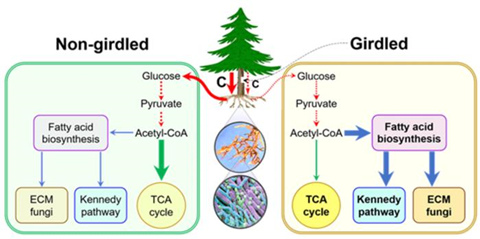Most plants have formed symbioses with mycorrhizal fungi since their emergence on land hundreds of millions of years ago. Depending on the availability of carbon (C), these symbioses employ two nutrient acquisition strategies: (i) via mycorrhizal fungi and (ii) via roots. While nutrient acquisition through symbiotic ectomycorrhizal fungi is C costly, it is fundamental for plant growth, community and ecosystem functioning.

In a new study published in Plant Diversity, a team led by Deliang Kong from Henan Agricultural University investigated the responses of roots and mycorrhiza to C limitation in mature ectomycorrhizas trees, Pinus taeda, offering new knowledge of mycorrhizal association with host roots. The team used girdling treatment to simulate C limitation and root samples in the ingrowth bags after root pruning were harvested seven months after the girdling.
READ MORE: Dual associations with two fungi improve tree fitness
READ MORE: A relationship with benefits: microfungi’s important role in plant health
“We hypothesized that tree girdling will cause a shift of nutrient acquisition from symbiotic mycorrhizal fungi to roots, given the high C cost in maintaining the mycorrhizal association,” shares Kong. “To test this hypothesis, we analyzed a suite of traits depicting root and mycorrhizal strategies.”
Molecular insights
Root transcriptome analysis was also conducted to gain molecular insight into the shift of nutrient acquisition strategies in response to the C limitation. The researchers found that that root physiological activity — measured as root nitrogen content and root exudation — declined after girdling and was accompanied by 110% and 340% increases in mycorrhizal colonization and extramatrical hyphal length, respectively.

Notably, fungal communities within roots changed to that characterized by higher C efficiency (lower C cost) of nutrient acquisition (CENA, the amount of nutrient acquisition per unit C cost) and lower network complexity, indicating a tradeoff between CENA and stability of the fungal community.
Shift in metabolic pathway
“Root transcriptome analysis suggested a shift in metabolic pathway from a tricarboxylic acid cycle for carbohydrate decomposition to lipid biosynthesis to maintain closer associations with mycorrhiza for nutrient cycling after the girdling,” explains Kong.
By integrating multi-level evidence, including root morphology, physiology, transcriptome, fungal composition and network complexity, the findings demonstrated an unexpected shift in the nutrient acquisition strategy, from roots to mycorrhiza of a pine species under the girdling-induced C-limiting — which is likely due to a shift to fungal community with higher CENA at the cost of lower stability.







No comments yet